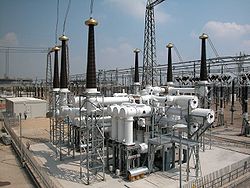An Automated AC Interference Analysis Software
Right-of-Way Pro is the ideal tool for accurately computing voltages and currents transferred from electric power lines and cables (by inductive, capacitive and through-earth coupling) to pipelines, railways, communication lines and other such utilities, whether buried or aboveground. The Right-of-Way Pro software package consists of a powerful set of integrated engineering software modules designed to accurately analyze these interference problems and provide mitigation with a global perspective, starting literally from the ground up.
|
This powerful integrated software package analyses the electromagnetic interference between electric power lines and adjacent installations such as pipelines, railways and communication lines. It is especially designed to simplify and to automate the modeling of complex Right-of-Way Pro configurations. Furthermore, Right-of-Way Pro can automatically create phase-to-ground faults along any transmission line at regular intervals throughout the Right-of-Way Pro corridor, as specified by the user. This automation process yields the envelope (curve of the maxima) of quantities such as pipeline GPR (i.e., ground potential rise), pipeline longitudinal and leakage currents, rail GPR or rail to rail voltages, tower potentials and earth injection currents, etc., along the Right-of-Way Pro.
Various software utilities, such as circuit plotting and Right-of-Way Pro mapping modules, are available to help you visualize and validate your input data. The full Right-of-Way Pro-Pro software includes the TRALIN (TRAnsmission LINe parameters), SPLITS (Simulation of Power Lines, Interconnections and Terminal Stations), RESAP (Soil Resistivity Analysis), and MALZ (Low and high frequency grounding) engineering modules and several other related tools (such as ModSPLITS) and components. The standard Right-of-Way Pro user interface essentially consists of several main integrated modules:
- Project management, setup and general information & data (Project, Setup & Settings)
- Building the Right-of-Way Pro system (Build System Configuration)
- Creating the original circuit model (Create Circuit)
- Manipulating a Right-of-Way Pro circuit input (or SPLITS input) compatible file (Modify Circuit)
- Assigning and monitoring faults along a Right-of-Way Pro (Monitor Fault)
- Creating the so -called Total AC interference model that combines inductive and conductive interference in one step analysis(Total Interference)
- Processing the input data and carrying out the required computations (Process)
- Plotting and reporting all system input data and computation results (Report)
The first module takes care of various aspects of project management and allows you to modify the limits of various parameters such as number of terminals, number of conductors, etc. You can also specify common system data such as system of units and power frequency.

The second module builds the Right-of-Way Pro circuit model through a series of intuitive windows interfaces, then automatically computes the required line parameters to produce the complete input data file that is then ready to be energized, either by normal load currents or fault currents.

The Create Circuit module builds the original circuit model of the network that will be used to carry out the computations.

The fourth module uses a specialized tool (ModSPLITS) to retrieve data from, and make modifications to a SPLITS-compatible input file initially produced by Right-of-Way Pro or any other application of the SES software subpackages.

The fifth module in Right-of-Way Pro allows the user to automatically model faults along a transmission line, at any combination of group of sections (spans), with the possibility to define arbitrary section increments between applied faults. The program will generate summary files containing useful information about the monitored "victim" phase conductor (pipeline, railways etc.) and a reference phase conductor (ground-wire, etc.) at every span (section) of the circuit.

The sixth module allows a user to automatically create a (MALZ) computer model of the grounding systems (including tower structure grounds) and mitigation wires along the target Right-of-Way Pro that may have an influence on the conductive interference with the full EMF(induction) components integrated in the model. The EMF components are used to account for the induced effects on a victim line due to currents flowing in phase conductors, overhead ground wires or other victim lines. They represent the inductive interference that was calculated by the circuit model computation engine. As a result, the MALZ grounding analysis engineering module gives the total interference level (conductive and inductive components) under fault conditions rather than the conductive component only.

The Process module is in charge of calculating the inductive & capacitive interference levels during load or fault conditions as well the total interference inductive and conductive levels during fault conditions, including current and voltage distributions.

Finally, the Plot & Report module provides various utilities, e.g.: system input & computation results reporting, circuit plotting and envelope curve plotting.


Right-of-Way Pro provides the following capabilities:
- Accommodates any arrangement of multi-phase conductors: pipe-enclosed cables, pipelines, solid, hollow, stranded and composite conductors, insulated and bare conductors, overhead and buried conductors, and irregular phase configurations. All cable conductors can have a core, sheath, armor, and arbitrary insulations.
- For overhead conductor arrangements with little regularity, conductors can be specified one at a time and may be completely different from one another. For systems which include buried conductors such as pipelines and pipe-enclosed cables, conductors are specified individually or as a group.
- An extensive conductor database is available to ease input operations. Add your own products to the databases at any time.

- Analyzes electromagnetic interference effects, currents and voltages in every span of a multi-conductor, multi-phase power network and in neighboring victim circuits sharing the same corridor. Ground impedances or interconnections to other conductors can be specified for any number of conductors at any number of locations. Key screens provide illustrations clearly representing the data to be entered and extensive on-line context-sensitive help is one keystroke or mouse click away.
- Plots the leakage current, longitudinal current, or GPR throughout your conductor network, directly on a schematic diagram of the network. For fault current distribution analyses or Right-of-Way Pro simulations, use GRSplits to plot multiphase networks, transmission line impedances, voltages, and currents as a function of distance or span number. Spreadsheet functions ease and speed up data entry. An input/output processor is available to view the circuit model represented by a Right-of-Way Pro or SPLITS input file. This tool greatly simplifies the task of manipulating, viewing and checking the components of the specified circuit. The most salient features of this utility are: The entire circuit or only the parts of interest can be plotted. This means that it is possible to focus on a small area or some specified sections (spans) to view or print the numerical values of the longitudinal and shunt (leakage) impedances on a drawing of the circuit. Connections which were specified between the various phases of a given section are also displayed when their impedance is below a specified threshold value. Identical sections are replaced by a single section, followed by dashed lines if desired. Computation results, such as GPR and longitudinal or shunt currents can be displayed at all locations, at selected zones and for a range of sections as required. Plots can be produced in most popular formats.
~
When you need an explanation or a rapid reminder of what any portion of a screen is for, simply click on that part of the screen, then press F1 function key and a context-sensitive help screen pops up instantly. If you have questions that the help file and the manuals do not immediately answer your questions, SES experts are just one toll-free phone away or if you prefer, email or fax your questions for prompt and thorough answers.

Documentation is a critical item when dealing with engineering software. Potential users should examine thoroughly the documentation in order to properly evaluate a software package. SES regularly publishes technical papers in Transactions journals and presents papers at various international conferences on engineering topics related to power system grounding (including analysis of transients and lightning), EMF studies and AC interference. SES also undertakes landmark applied R&D studies in these areas. These studies have not ever been undertaken before with the accuracy and detail of which our modern computer-based technology is capable today. This R&D is now being distilled into "How To..." engineering manuals at a level of detail designed for both novices and advanced users who encounter similar problems and wish to model them with the SES software. These unique, detailed, step-by-step "How To..." engineering manuals guide you through the most complex analysis and design projects (both the engineering concepts, and the use of the software are described).
SES distributes a complete documentation set with its software in electronic form (on CD-ROM) and provides hard copy as well. Furthermore, significant information on new or updated software is made available on the SES web site. The main documentation set supplied with the software package consists of Quick Installation and System Requirements sheets and booklets, a Getting Started manual, a “How to...”. engineering manual, on-line context sensitive help, Annual Users' Group Meeting Proceedings, Users' Group Newsletters, and an extensive Technical Reference document containing a detailed description of the analytical methods used by the various SES engineering modules.
Accuracy and Validation
If there is an item which is of primary importance when dealing with engineering software, it is definitely validation & accuracy. Extensive scientific validation of the software by means of field tests and comparisons with analytical and published research results is documented in hundreds of technical papers published by the most reputed international journals. Each module has been tested to insure that it produces the correct results for a large number of cases documented at SES, which include several fundamental cases available to users on CD-ROM. The evolving software is continuously validated over the years using the following three well documented mechanisms:
- Field Tests and Experimental Scale Models
- Comparisons with Scientific Published Results
- Comparison with Similar Programs Using Completely Different Techniques







